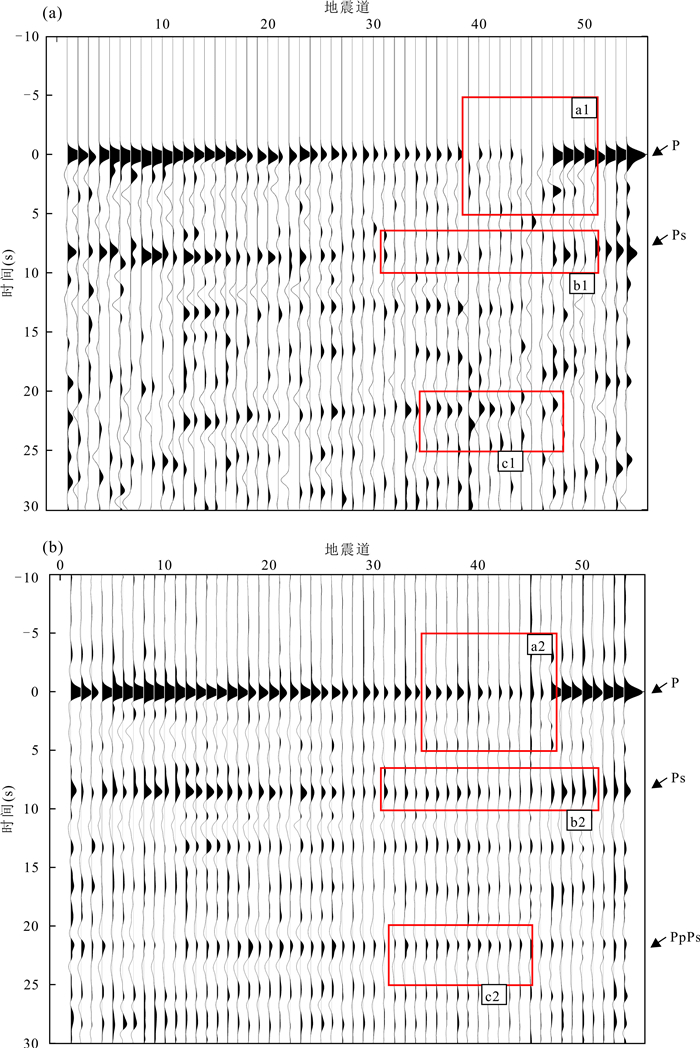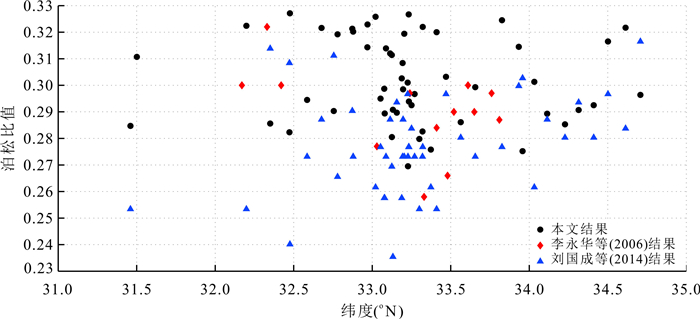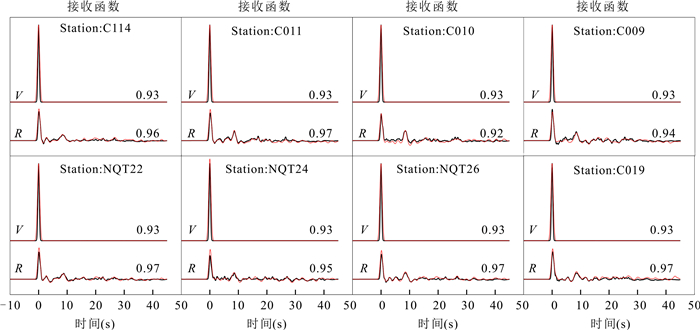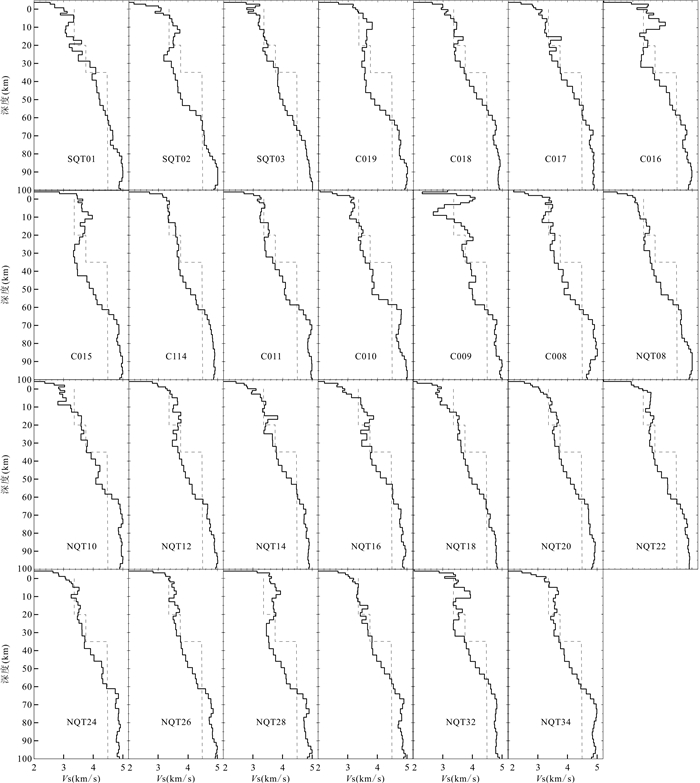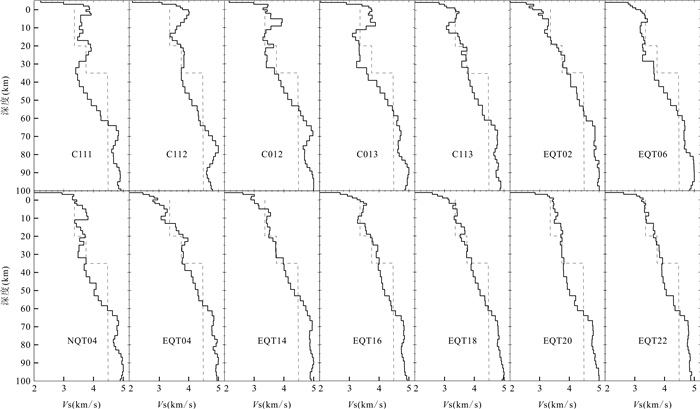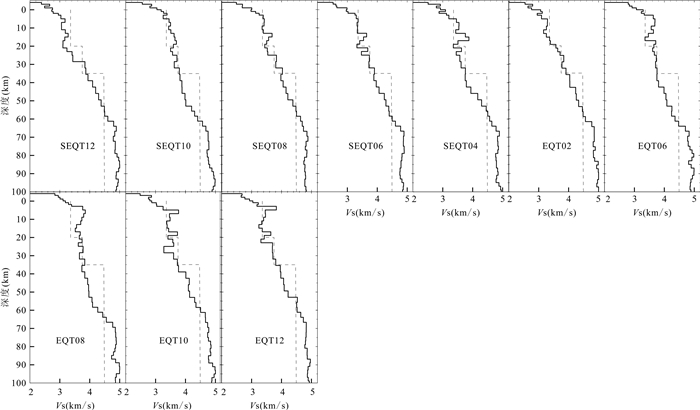Low Velocity Layer Investigation in Central Qiangtang in North Tibet and Its Dynamic Implications
-
摘要: 为了调查羌塘盆地中部壳内低速层分布特征,对布设在羌塘盆地的TITAN-Ⅰ宽频带地震台站所记录的远震波形数据进行接收函数分析,并引入时频域相位滤波技术改善接收函数信噪比,反演得到各台站下方100 km深度范围内的一维S波速度结构.结果表明,时频域相位滤波方法能够显著提高信噪比;羌塘盆地Moho深度为58±6 km,具有较高的泊松比值;中下地壳壳内低速层广泛分布,横向不连续,埋深在20~30 km,层厚6~12 km,剪切波速度为3.4±0.1 km/s;部分地区在埋深为10 km的中上地壳存在一层厚约4 km的低速薄层.羌塘盆地中下地壳壳内低速层是由于上涌的深部软流圈物质与下地壳发生大范围的接触,造成壳内及上地幔部分熔融引起的.Abstract: In order to investigate the distribution characteristics of the low velocity layer in the central Qiangtang basin, this study conducted the TITAN-Ⅰ teleseismic receiver functions across the Qiangtang basin. And the signal-to-noise ratio of the receiver function was improved by the phase filtering technique in the time frequency domain. Finally, the one-dimensional S wave velocity structure in the depth of 100 km below each station is obtained by the nonlinear inversion of conjugate gradients algorithm for the complex spectrum ratios of receiver function. The results show that the phase filtering method in the time frequency domain can significantly improve the signal-to-noise ratio and make the one-dimensional S wave velocity structure of the subsequent inversion more reliable. The Moho depth of the Qiangtang basin is 58 ±6 km, and where has a higher Poisson's ratio. The low velocity layer in the mid-lower crust is widely distributed. The transverse discontinuity is discontinuous, and the depth is between 20 and 30 km, the thickness of the layer is 6-12 km, the shear wave velocity is 3.4±0.1 km/s. In some areas, there is a thin layer of 4 km thin layer in the mid-upper crust with a depth of 10 km. The low velocity layer in the mid-lower crust of the Qiangtang basin is caused by the deep mantle derived magma upwelling along the tectonic weak zone, resulting in partial melting in the mid-lower crust and upper mantle.
-
图 5 羌塘中部泊松比分布
黑色圆点是本文的结果;红色菱形是李永华等(2006)用INDEPTH⁃Ⅲ得到的结果;蓝色三角形是刘国成等(2014)H⁃K扫描得到的结果
Fig. 5. Poisson ratio in central Qiangtang
表 1 台站位置及Moho深度和泊松比
Table 1. Locations of broadband stations and measured Moho depth and σ
台站 经度(°E) 纬度(°N) Moho(±2 km) σ(±0.001) 接收函数数量 台站 经度(E) 纬度(N) Moho(±2 km) σ(±0.001) 接收函数数量 C008 88.49 33.37 61.2 0.265 54 NQT04 89.26 33.12 58.6 0.335 33 C009 88.39 33.30 61.3 0.215 56 NQT06 89.19 33.20 58.6 0.335 48 C010 88.59 33.32 58.4 0.270 61 NQT08 88.48 33.47 58.3 0.305 30 C011 88.33 33.23 58.6 0.250 66 NQT10 88.53 33.56 58.4 0.260 34 C012 88.08 33.23 53.2 0.350 82 NQT12 88.54 33.66 61.2 0.310 32 C013 88.22 33.19 55.8 0.325 66 NQT14 88.78 33.83 53.9 0.350 21 C015 88.30 33.05 61.2 0.295 47 NQT16 88.78 33.93 53.8 0.335 31 C016 88.45 33.02 58.5 0.350 29 NQT18 88.71 33.96 61.1 0.250 22 C017 88.47 32.97 53.1 0.345 35 NQT20 88.63 34.03 61.1 0.310 21 C018 88.42 32.87 53.1 0.340 30 NQT22 88.64 34.11 61.1 0.270 45 C019 88.48 32.75 61.3 0.285 56 NQT24 88.62 34.23 61.2 0.275 54 C111 87.90 33.23 61.3 0.310 68 NQT26 88.58 34.31 61.2 0.285 52 C112 87.92 33.16 64.1 0.265 28 NQT28 88.56 34.41 61.3 0.290 51 C113 88.74 33.27 60.9 0.300 43 NQT30 88.62 34.50 55.9 0.340 53 C114 88.67 33.08 61.3 0.280 52 NQT32 88.66 34.61 55.8 0.345 64 EQT02 88.96 33.11 52.9 0.335 60 NQT34 88.46 34.71 61.3 0.295 52 EQT04 89.37 33.13 55.7 0.235 64 SEQT02 89.54 32.97 53.9 0.345 23 EQT06 89.53 33.08 61.1 0.315 44 SEQT04 89.64 32.88 53.0 0.350 24 EQT08 89.55 33.19 63.9 0.335 41 SEQTO6 89.70 32.78 58.8 0.345 31 EQT10 89.51 33.32 58.4 0.350 36 SEQT08 89.72 32.68 52.9 0.345 31 EQT12 89.53 33.41 53.2 0.350 39 SEQT10 89.76 32.59 61.2 0.295 29 EQT14 89.69 33.09 53.0 0.335 25 SEQT12 89.70 32.48 53.2 0.345 25 EQT16 89.81 33.13 61.3 0.285 27 SQT01 88.63 32.20 58.8 0.345 106 EQT18 89.88 33.20 58.5 0.305 26 SQT02 88.64 32.35 61.6 0.275 60 EQT20 90.02 33.23 61.2 0.295 21 SQT03 88.61 32.47 64.2 0.270 51 EQT22 90.15 33.25 61.1 0.290 21 表 2 中下地壳低速层分布情况
Table 2. Low velocity layer distribution in the mid⁃lower crust
台站号 顶面埋深(±0.5 km) 底面埋深(±0.5 km) 厚度(±1.0 km) 台站号 顶面埋深(±0.5 km) 底面埋深(±0.5 km) 厚度(±1.0 km) SQT01 20 30 10 NQT20 20 30 10 SQT02 22 30 8 NQT22 20 29 9 SQT03 22 30 8 NQT26 20 30 10 C018 18 29 11 NQT28 24 34 10 C017 24 30 6 NQT32 19 30 11 C016 21 32 11 NQT34 19 29 10 C015 25 35 10 C012 20 30 10 C011 21 31 10 C013 22 30 8 C010 20 29 9 NQT06 20 28 8 C008 23 35 12 NQT04 22 31 9 NQT08 19 25 6 EQT10 19 31 12 NQT16 22 30 8 -
Ammon, C. J., Randall, G. E., Zandt, G., 1990. On the Nonuniqueness of Receiver Function Inversions. Journal of Geophysical Research, 95(B10):15303-15318. doi: 10.1029/JB095iB10p15303 Ammon, C.J., Zandt, G., 1993.Receiver Structure beneath the Southern Mojave Block, California. Bulletin of the Seismological Society of America, 83(3):737-755. Chi, X.G., Zhang, R., Fan, L.F., et al., 2017.The Formatting Mechanism of Cenozoic Basaltic Volcanic Rocks in the Northern Tibet:Continental Subduction and Slab Breakoff Driven by Mantle Convection and Upwelling. Acta Petrologica Sinica, 33(10):3011-3026(in Chinese with English abstract). http://en.cnki.com.cn/Article_en/CJFDTOTAL-YSXB201710003.htm Cui, Z. Z., Yin, Z. X., Gao, E. Y., et al., 1990. The Structure and Tectonics of the Crust and Their Relation with Earthquakes in the Qinghai-Xizang Plateau.Acta Geoscientica Sinica, 11(2):215-232(in Chinese with English abstract). http://en.cnki.com.cn/Article_en/CJFDTOTAL-DQXB199002020.htm Gao, R., Chen, C., Lu, Z.W., et al., 2013.New Constraints on Crustal Structure and Moho Topography in Central Tibet Revealed by SinoProbe Deep Seismic Reflection Profiling. Tectonophysics, 606:160-170. https://doi.org/10.1016/j.tecto.2013.08.006 Gao, X., Wang, W.M., Yao, Z.X., et al., 2005.Crustal Structure of China Mainland and Its Adjacent Regions. Chinese Journal of Geophysics, 48(3):591-601(in Chinese with English abstract). http://www.wanfangdata.com.cn/details/detail.do?_type=perio&id=dqwlxb200503017 Guo, X.F., Zhang, Y.C., Cheng, Q.Y., et al., 1990.Magnetotelluric Studies along Yadong-Golmud Geosciences Transect in Qinghai-Xizang Plateau.Acta Geoscientia Sinica, 22(2):191-202(in Chinese with English abstract). http://en.cnki.com.cn/article_en/cjfdtotal-dqxb199002018.htm Haines, S. S., Klemperer, S. L., Brown, L., et al., 2003. INDEPTH Ⅲ Seismic Data:From Surface Observations to Deep Crustal Processes in Tibet. Tectonics, 22(1):1001. https://doi.org/10.1029/2001tc001305 He, R.Z., Gao, R., Hou, H.S., et al., 2009.Deep Structure of the Central Uplift Belt in the Qiangtang Terrane, Tibet Plateau from Broadband Seismic Observations and Its Implications. Progress in Geophysics, 24(3):900-908(in Chinese with English abstract). http://www.wanfangdata.com.cn/details/detail.do?_type=perio&id=dqwlxjz200903012 Huang, J. J., 2001. Structural Characteristics of the Basement of the Qiangtang Basin. Acta Geologica Sinica, 75(3):333-337(in Chinese with English abstract). http://d.old.wanfangdata.com.cn/Conference/8633148 Jiménez-Munt, I., Fernàndez, M., Vergés, J., et al., 2008.Lithosphere Structure underneath the Tibetan Plateau Inferred from Elevation, Gravity and Geoid Anomalies.Earth and Planetary Science Letters, 267(1-2):276-289. https://doi.org/10.1016/j.epsl.2007.11.045 Kind, R., Ni, J., Zhao, W., et al., 1996. Evidence from Earthquake Data for a Partially Molten Crustal Layer in Southern Tibet. Science, 274(5293):1692-1694. https://doi.org/10.1126/science.274.5293.1692 Li, C., Dong, Y.S., Zhai, Q.G., et al., 2008.Discovery of Eopaleozoic Ophiolite in the Qiangtang of Tibet Plateau:Evidence from SHRIMP U-Pb Dating and Its Tectonic Implications.Acta Petrologica Sinica, 24(1):31-36(in Chinese with English abstract). Li, Y.H., Tian, X.B., Wu, Q.J., et al., 2006.The Poisson Ratio and Crustal Structure of the Central Qinghai-Xizang Inferred from INDEPTH-Ⅲ Teleseismic Waveforms:Geological and Geophysical Implications. Chinese Journal of Geophysics, 49(4):1037-1044(in Chinese with English abstract). Liu, Q, Y., 1996.Maximal Likelihood Estimation and Nonlinear Inversion of the Complex Receiver Runction Spectrum Ratio. Chinese Journal of Geophysics, 39(4):500-511(in Chinese with English abstract). Liu., G.C., Shang, X.F., He, R.Z., et al., 2014.Topography of Moho beneath the Central Qiangtang in North Tibet and Its Geodynamic Implication.Chinese Journal of Geophysics, 57(7):2043-2053(in Chinese with English abstract). Mechie, J., Sobolev, S.V., Ratschbacher, L., et al., 2004.Precise Temperature Estimation in the Tibetan Crust from Seismic Detection of the α-β Quartz Transition.Geology, 32(7):601-604. https://doi.org/10.1130/g20367.1 Nelson, K. D., Zhao, W., Brown, L. D., et al., 1996. Partially Molten Middle Crust beneath Southern Tibet:Synthesis of Project INDEPTH Results.Science, 274(5293):1684-1688. https://doi.org/10.1126/science.274.5293.1684 Qu, Z.D., He, R.Z., Zhang, X.H., et al., 2017.The Time-Frequency Domain Phase Filter and Its Application in Noise Suppression of Teleseismic Receiver Functions. Chinese Journal of Geophysics, 60(4):1389-1397(in Chinese with English abstract). http://en.cnki.com.cn/Article_en/CJFDTotal-DQWX201704013.htm Replumaz, A., Negredo, A.M., Guillot, S., et al., 2010.Multiple Episodes of Continental Subduction during India/Asia Convergence:Insight from Seismic Tomography and Tectonic Reconstruction.Tectonophysics, 483(1-2):125-134. https://doi.org/10.1016/j.tecto.2009.10.007 Shi, D. N., Zhao, W. J., Brown, L., et al., 2004. Detection of Southward Intracontinental Subduction of Tibetan Lithosphere along the Bangong-Nujiang Suture by P-to-S Converted Waves. Geology, 32(3):209. https://doi.org/10.1130/g19814.1 Stockwell, R.G., 1999.S-Transform Analysis of Gravity Wave Activity from a Small Scale Network of Airglow Imagers.The University of Western Ontario, Canada, 4662. Sun, M., Chen, W., Qu, X.M., et al., 2018.Petrogenesis of the Late Cretaceous Jiangba Volcanic Rocks and Its Indications for the Thinning of the Thickened Crust in Xiongmei Area, Tibet.Earth Science, 43(9):3234-3251(in Chinese with English abstract). http://d.old.wanfangdata.com.cn/Periodical/dqkx201809022 Tarantola, A. P., 1987. Inverse Problem Theory:Methods for Data Fitting and Model Parameter Estimation.Physics of the Earth & Planetary Interiors, 57(3):350-351. Teng, J.W., Ruan, X.M., Zhang, Y.Q., et al., 2012.The Stratifficational Velocity Structure of Crust and Covering Strata of Upper Mantle and the Orbit of Deep Interaquifer Substance Locus of Movement for Tibetan Plateau.Acta Petrologica Sinica, 28(12):4077-4100(in Chinese with English abstract) http://en.cnki.com.cn/Article_en/CJFDTotal-YSXB201212022.htm Wang, C.S., Hu, C.Z., Wu, R.Z., et al., 1987.Significance of the Discovery of Chasang-Chabu Rift in Northern Xizang(Tibet). Journal of Chengdu College of Geology, 14(2):33-46(in Chinese with English abstract). Wang, W., Gao, X., Li, Y. Y., et al., 2011. Crustal Velocity Structure of S-Wave beneath Tibetan Plateau with Transform Function Method-Hi-Climb Profile. Chinese Journal of Geophysics, 54(6):766-776. https://doi.org/10.1002/cjg2.1660 Watanabe, T., 1993.Effects of Water and Melt on Seismic Velocities and Their Application to Characterization of Seismic Reflectors. Geophysical Research Letters, 20(24):2933-2936. https://doi.org/10.1029/93gl03170 Wu, G. J., Xiao, X. C., Li, T. D., 1989. The Yadong-Golmud Geoscience Section on the Qinghai-Tibet Plateau. Acta Geologica Sinica, 63(4):285-296(in Chinese with Eng-lish abstract). http://en.cnki.com.cn/Article_en/CJFDTotal-DZXE198904000.htm Wu, Q.J., Zeng, R.S., 1998.The Crustal Structure of QinghaiXizang Plateau Inferred from Broadband Teleseismic Waveform. Chinese Journal of Geophysics, 41(5):669-679(in Chinese with English abstract). http://en.cnki.com.cn/Article_en/CJFDTOTAL-DQWX199805010.htm Wu, W., Liu, Q. Y., He, R. Z., et al., 2017. Waveform Inversion of S-Wave Velocity Model in the Central Qiangtang in North Tibet and Its Geological Implications. Chinese Journal of Geophysics, 60(3):941-952(in Chinese with English abstract). http://www.en.cnki.com.cn/Article_en/CJFDTotal-DQWX201703010.htm Zhang, S. Y., Zhang, X. J., 1996. Magnetotelluric Sounding in the Qiangtang Basin of Xizang (Tibet).Earth Science, 21(2):98-102(in Chinese with English abstract). Zhao, Z., Lu, L., Wu, Z.H., et al., 2018.Charactreistics of the Late Triassic Jiangai Granite Mass and the Slab Breakoff in Central Qiangtang, Tibet. Earth Science, 43(Suppl.1):225-242(in Chinese with English abstract). http://en.cnki.com.cn/Article_en/CJFDTotal-DQKX2018S1021.htm Zou, C.Q., He, R.Z., Gao, R., et al., 2012.Deep Structure of the Central Uplift Belt in the Qiangtang Terrane Tibetan Plateau from Teleseismic P-Wave Tomography.Chinese Science Bulletin, 57(28-29):2729-2739(in Chinese). doi: 10.1360/972011-2430 迟效国, 张蕊, 范乐夫, 等, 2017.藏北新生代玄武质火山岩起源的深部机制:大陆俯冲和板片断离驱动的地幔对流上涌模式.岩石学报, 33(10):3011-3026. http://d.old.wanfangdata.com.cn/Periodical/ysxb98201710003 崔作舟, 尹周勋, 高恩元, 等, 1990.青藏高原地壳结构构造及其与地震的关系.地球学报, 11(2):221-232. http://www.wanfangdata.com.cn/details/detail.do?_type=perio&id=HY000001812316 高星, 王卫民, 姚振兴, 等, 2005.中国及邻近地区地壳结构.地球物理学报, 48(3):591-601. doi: 10.3321/j.issn:0001-5733.2005.03.017 郭新峰, 张元丑, 程庆云, 等, 1990.青藏高原亚东-格尔木地学断面岩石圈电性研究.地球学报, 22(2):191-202. http://www.wanfangdata.com.cn/details/detail.do?_type=perio&id=HY000002240792 贺日政, 高锐, 侯贺晟, 等, 2009.羌塘中央隆起带深部结构特征研究及其意义.地球物理学进展, 24(3):900-908. doi: 10.3969/j.issn.1004-2903.2009.03.012 黄继钧, 2001.羌塘盆地基底构造特征.地质学报, 75(3):333-337. doi: 10.3321/j.issn:0001-5717.2001.03.006 李才, 董永胜, 翟庆国, 等, 2008.青藏高原羌塘早古生代蛇绿岩:堆晶辉长岩的锆石SHRIMP定年及其意义.岩石学报, 24(1):31-36. http://d.old.wanfangdata.com.cn/Periodical/ysxb98200801002 李永华, 田小波, 吴庆举, 等, 2006.青藏高原INDEPTH-Ⅲ剖面地壳厚度与泊松比:地质与地球物理含义.地球物理学报, 49(4):1037-1044. doi: 10.3321/j.issn:0001-5733.2006.04.015 刘国成, 尚学峰, 贺日政, 等, 2014.藏北羌塘盆地中部莫霍面形态及其动力学成因.地球物理学报, 57(7):2043-2053. 刘启元, 1996.接收函数复谱比的最大或然性估计及非线性反演.地球物理学报, 39(4):500-511. doi: 10.3321/j.issn:0001-5733.1996.04.008 曲中党, 贺日政, 张训华, 等, 2017.时频域相位滤波在远震接收函数噪声压制中的应用.地球物理学报, 60(4):1389-1397. http://www.cnki.com.cn/Article/CJFDTotal-DQWX201704013.htm 孙渺, 陈伟, 曲晓明, 等, 2018.西藏雄梅地区晚白垩世江巴组火山岩岩石成因及对加厚地壳减薄的指示.地球科学, 43(9):3234-3251. http://earth-science.net/WebPage/Article.aspx?id=3939 滕吉文, 阮小敏, 张永谦, 等, 2012.青藏高原地壳与上地幔成层速度结构与深部层间物质的运移轨迹.岩石学报, 28(12):4077-4100. http://d.old.wanfangdata.com.cn/Periodical/ysxb98201212022 王成善, 胡承祖, 吴瑞忠, 等, 1987.西藏北部查桑-茶布裂谷的发现及其地质意义.成都地质学院学报, 14(2):33-46. http://www.cnki.com.cn/Article/CJFDTotal-CDLG198702003.htm 吴功建, 肖序常, 李廷栋, 1989.青藏高原亚东-格尔木地学断面.地质学报, 63(4):285-296. doi: 10.3321/j.issn:0001-5717.1989.04.003 吴庆举, 曾融生, 1998.用宽频带远震接收函数研究青藏高原的地壳结构.地球物理学报, 41(5):669-679. doi: 10.3321/j.issn:0001-5733.1998.05.010 吴蔚, 刘启元, 贺日政, 等, 2017.羌塘盆地中部地区地壳S波速度结构及构造意义.地球物理学报, 60(3):941-952. http://www.cnki.com.cn/Article/CJFDTOTAL-DQWX201703010.htm 张胜业, 张先觉, 1996.西藏羌塘盆地大地电磁测深研究.地球科学, 21(2):98-102. http://earth-science.net/WebPage/Article.aspx?id=369 赵珍, 陆露, 吴珍汉, 等, 2018.羌塘中部晚三叠世江爱岩体特征与板片断离作用.地球科学, 43(增刊1):225-242. http://earth-science.net/WebPage/Article.aspx?id=3961 邹长桥, 贺日政, 高锐, 等, 2012.远震P波层析成像研究羌塘中央隆起带深部结构.科学通报, 57(28-29):2729-2739. http://www.wanfangdata.com.cn/details/detail.do?_type=perio&id=kxtb201228009 -










 下载:
下载:

